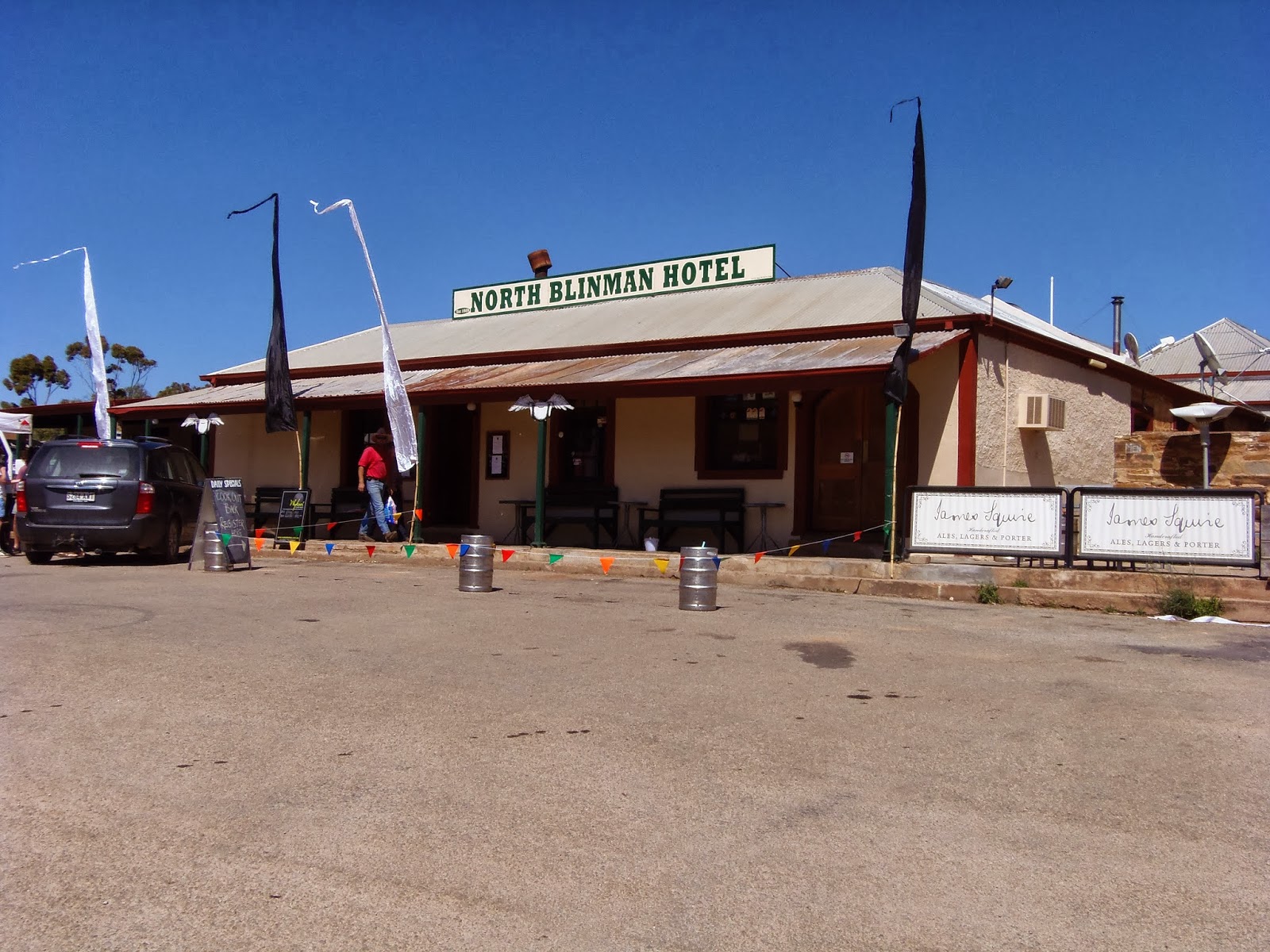The rest of the road to Blinman to the east was undulating and winding with a reasonable surface. I was getting low on fuel so was grateful to come across Angorichina Village and a Roadhouse. Blinman Pools reached by a 12 km walk is popular and there were a few preparing for the hike.
Blinman, the highest town in SA is a Boutique place with a Pub, general Store and a few old buildings. It was busy due to a Camp Oven cooking competition being held by a 4x4 club on the weekend that I visited. Another attraction are the ruins of the old Blinman Copper mine. copper was found in the area in 1859 by a one-legged shepherd called "Peg Leg" Blinman. The town boomed for about a decade after until all the Copper had been removed.
Wilpena Pound is the last "attraction" to be found in the Flinders. It is in fact a Resort with an adjoining very big bush style Caravan and Camping Park. Indeed it was almost full with holiday makers, including plenty of kids, many families in their Tents erected close together. I stayed to use the facilities, especially a long hot shower which is a luxury sometimes for me.
The last leg is back to Hawker where I will end my visit to the Flinders Ranges and head south east towards Renmark to follow the Murray River for a while.
Search This Blog
Thursday 17 October 2013
BACK to PARACHILNA and the GORGE
I returned to the Prairie Hotel at Parachilna since I needed to take the 35 km dirt road that led to Blinman and the Eastern Flinders Ranges. Parachilna Gorge is another wilderness area that is about 12 kms from the Pub. Very different to Warren Gorge, Parachilna stretches along the dry bed of what was once a large river with scattered campsites for about 5 kms. The fact that it was School holidays was evident as most of the suitable camp sites were occupied with Caravans, Trailers and Tents. I found a place that I could share and still keep my distance. I would like to come back one day when it was a bit quieter and explore a bit deeper.
 |
| Evidence of a more permanent home here for some in the past |
FARINA RUINS SA
The road to Farina wasn't too bad but needed caution in some parts with fairly deep ruts and sections of loose sand. At times I needed to reduce speed to around 20 - 30 kph to be safe. Farina is locate in desert country. Why would anyone want to live here I mused. The following description of farina provided by the Farina Restoration Society my explain:
"Farina is located within the Lake Eyre Basin, on the old alignment of the Ghan railway, 600 km north of Adelaide. It is 26 km north of Lyndhurst and 55 km south of Marree.
No longer inhabited, it was originally surveyed and proclaimed a town on 21 March 1878. It was first known as ‘Government Gums’ because of the mature River Red Gums in the creek to the north of the town but later its name was changed to “Farina” (Latin for wheat or flour) by farmers who optimistically hoped to turn the vast flat lands here into fields of grain.
432 quarter acre blocks were laid out during the 1880s with a population of about 100 adults and 50 children which tripled by the end of the decade. With the introduction of the northern railway known as the Ghan, it became the rail head from Port Augusta in 1882 until the line was extended to Marree two years later (eventually making Oodnadatta in 1891 and Alice Springs in 1929).
With good rains, Farina flourished and the population rose to about 600 at its peak with a bakery, grain store, two breweries, two hotels, a general store, post office, an Anglican church, cemetery, five blacksmiths, a school and even a brothel. However, years of drought and dust storms, the closing of the gold and silver mines nearby in 1927 and re-alignment of the Ghan railway line during the 1980s forced the eventual abandonment of the town."
During an interesting walk through the ruins I thought of what it would have been like here in the 1880's with new residents either excited about their prospects of a future or wondering what they had got themselves into. I am surprised that the town lasted as long as it did.
For those interested the Info Boards give more details
 |
| Does this look like good farming land? Hardly! |
 |
| The Bakery Oven has been restored |
I found the camping ground, not far from the ruins, and was pleasantly surprised. A large, well planned Bush Camp beside a dry creek with individual campsites set under shade trees with a table made from railway sleepers, a BBQ and a Fire Ring. As I found out many different birds lived here and wild Emus came into the camp from time to time. There were also a couple of signposted Bush Walks, one in particular, the Wells walk that traced the history of the Town's water supply, I found interesting. At $5 per night via an Honesty Box I parked here for three bright, sunny, days. The 200 km round trip from Parachilna was worth it even just to camp with the ruins a bonus.
 |
| An old Wood Heater for the shower no longer works |
 |
| He got to within 10 metres before he saw me and ran off |
Subscribe to:
Posts (Atom)





















































